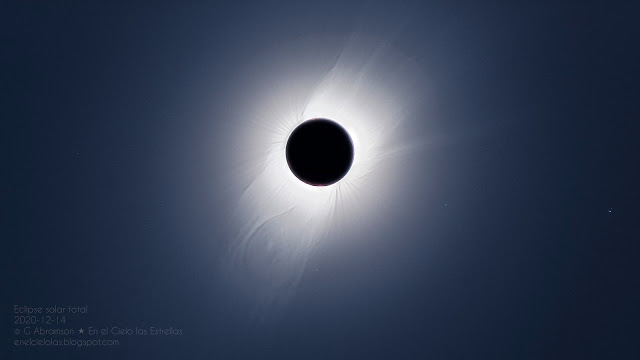There’s an old adage that says there is ‘nothing new under the Sun…’ but that doesn’t apply when it comes to solar eclipse science.
Beyond just providing an awesome celestial spectacle, astronomers have often taken advantage of the brief moments afforded by solar totality to explore the Sun and its environs. To this end, total solar eclipses have historically offered chances to carry out scientific experiments in the past, and continue to do so today.
For example, the element helium was first identified in the flash spectrum of the Sun in 1868. Sir Arthur Eddington successfully observed that gravity bends light, as seen by the deflection of stars near the solar limb during the total solar eclipse of 1919, successfully testing one of the predictions put forward by Einstein’s General theory of Relativity. This effort was first attempted in 1914, but was stalled by the advent of World War I.

Astronomers also made one last attempt to spy the inter-mercurial world Vulcan during the total solar eclipse of 1878 over the American West. And though the advent of relativistic physics also explained the anomalous precession of Mercury without evoking the existence of the spurious world of Vulcan, the existence of a hypothetical group of asteroids very near the Sun dubbed Vulcanoids has not yet been ruled out. NASA actually tasked a pair of converted WB-57 bombers to chase the shadow of the Moon during the 2017 eclipse, with a tertiary goal of sweeping the zone close to the Sun for spurious Vulcanoids. Thus far, however, searches have come up empty-handed.
What’s more, we’re still managing to tease out science results from total solar eclipses. A total solar eclipse offers a unique opportunity on several scientific fronts, including: 1). a chance to directly observe the illusive and usually invisible outer atmosphere of the Sun, to include the chromosphere and the corona; 2). a chance to scour the space very near the Sun for hereto unknown objects, and 3). a chance to use the large distorting gravity well of our host star for experiments.
One elusive phenomenon that occasionally appears during totality are coronal mass ejections. Until the advent of space-based coronagraphs starting with Skylab in the early 1970s, total solar eclipses were the only time astronomers could glimpse this poorly understood phenomenon. Even today, solar totality remains the only time we can glimpse the very beginnings of a coronal mass ejection forming close to the solar limb, as typical coronagraphs aboard solar observing missions such as the Solar Heliospheric Observatory (SOHO) tend to cover several solar diameters. Though brief, totality offers a much better fit of the Moon covering the Sun.
One such occurrence was recently caught by astronomer Guillermo Abramson during the December 14, 2020 total solar eclipse. The path of totality for this eclipse covered remote areas across the very southern tip of South America. Few eclipse-chasers made the trek to stand in the shadow of the Moon this time around, because of the ongoing pandemic and travel restrictions.

“Observations of the solar corona during eclipses, though rare, are extremely valuable and complementary to those made with coronagraphs, from ground and space,” Abramson told Universe Today. “The main reason is that the corona can be observed right to the solar limb during eclipses, while the coronagraphs’ masks tend to be larger.”

Not only did Abramson and his team manage to catch the entire anatomy of a CME in the act of formation, but comparison with observations from space-based assets including GOES, ACE and SOHO allowed for speed and velocity measurements as the CME progressed. The team also caught an extra bonus, verified by SOHO: the Kreutz Group sungrazing comet 2020 X3 SOHO). Comets have made themselves known during eclipses before; a famous example was the Great Eclipse Comet of 1948. It’s strange to think, that until the early 1990s less than a half dozen sungrazers were known of. Now, largely thanks to SOHO, we’ve chronicled 4,182 such comets and counting.

Another elusive mystery eclipse chasers are working to solve is what’s known as the the corona heating problem. What supercharges the tenuous solar corona to temperatures millions of degrees hotter than the layers below?
Enter the Solar Wind Sherpas, a team of astronomers who have chased eclipses worldwide, in an effort to understand this phenomenon. Based out of the Institute for Astronomy in Honolulu, Hawai’i, the Solar Wind Sherpas have followed the corona during eclipses for over a decade, or one 11-year solar cycle. Their efforts have come up with an unexpected finding: though sunspot activity fluctuates over the solar cycle, the temperature of the solar corona remains nearly constant, suggesting that whatever is heating the corona to tremendous temperatures is independent of the solar cycle.
“The temperature at the sources of the solar wind in the corona is almost constant throughout the solar cycle,” says Shadia Habbal (University of Hawaii) in a recent press release. “This finding is unexpected because coronal structures are driven by changes in the distribution of magnetized plasmas in the corona, which vary so much throughout the 11-year magnetic solar cycle.”

This intriguing find was published in Astrophysical Journal Letters. One solar heating suspect are what’s known as nanoflares, and missions such as NASA’s Parker Solar Probe and ESA’s Solar Orbiter are currently hard at work on this problem.
On average, we get a total solar eclipse or two somewhere on Earth every year, though this year’s offering is a bashful one, with totality gracing the Earth just one time across the Antarctic continent on December 4th, 2021. The U.S., however, is about to catch eclipse fever once again on April 8th, 2024, with the a total solar eclipse crossing Mexico, the United States and (get your Learjet ready) the Canadian Maritimes…

And as always, scientists will be onhand, to unlock the secrets of the Sun.
-Read Dr. Abramson’s account of chasing the ‘Great Patagonian Eclipse‘ on his blog.
-Lead image: An amazing view of the December 2020 total solar eclipse. G. Abramson.

